Soil acidity is one of the main limitations to agricultural production worldwide, affecting many chemical and biological reactions that control nutrient availability to plants. Plant root growth is reduced in acid soils, which increases the vulnerability of the crop to water stress and nutrient deficiency and reduces yields (Fageria and Nascente 2014). The acid soils represent approximately 30% of the total surface of the planet and more than 50% of potentially arable lands (Golla 2019). In southern Chile, from the Ñuble Region to the Los Lagos Region, soil pH is within the acid range of 4.5 to 5.5 (Bernier and Alfaro 2006), which means a significant degree of acidity in the soil.
Agricultural activity could accelerate soil acidification through increased leaching due to water movement in the soil, accumulation of organic matter, and soil amendment (fertilizers and other chemicals). Ammonium, which is the main nitrogen compound found in fertilizers, has the greatest potential for soil acidification, whereas nitrate-based nitrogen fertilizers have a weaker acidifying potential (Wang et al. 2021). For soil pH neutralization, lime can also be used. However, industrial and organic wastes can represent a great opportunity to produce organic-mineral fertilizers by using the three key principles (recycling, reusing, and reducing) for a circular economy with numerous agricultural and environmental advantages, such as improvement and contribution to the neutralization of soil acidity. In addition, the organic and industrial wastes also decrease trace elements availability to the plants due to their alkalinity (Muscolo et al. 2022).
The lettuce (Lactuca sativa L., var. Longifolia) is widely consumed as a salad because it contains several nutritional benefits, such as low levels of calories, fat, and sodium, while it contains an adequate source of fiber, iron, folic acid, and vitamin C (Vargas-Arcila et al. 2017). It has a short growth period which makes its production fast and economically viable (Ahmed et al. 2021a). The productive quality of lettuce leaves is based on the average leaf area and number of leaves, while total soluble solids and vitamin C content are used for physiological quality (Zapata-Vahos et al. 2020; Alneyadi et al. 2024). The measurement of vitamin C content in vegetables is based on the measurement of an antioxidant compound, ascorbic acid. Its derivatives have been tested on cancer cells and revealed anticancerous activity (Medina-Lozano et al. 2021). Ekinci et al. (2020) reported an increased chlorophyll value and vitamin C content when organic fertilizers are used in growing lettuce. Zhang et al. (2015)demonstrated that nitrogen (N), phosphorus (P), and potassium (K) when combined with organic fertilizer could increase vitamin C content in tomatoes. Consequently, the changes in the soil pH have an important impact on the quality of vegetables and represent an important agroecological factor.
Currently, there is a high availability of industrial and organic waste, such as seashells, food waste, and wood ashes that can be used as natural fertilizers (Ahmed et al. 2021b). In this context, seashells (75% CaCO3) and coffee beans with banana peels as food waste, together with wood ashes could contribute to neutralizing soil acidity, improving the physiological quality of the crop, and playing a key role as a source of NPK.
Therefore, the current study aimed to assess the impact of a natural waste-based fertilizer, composed of Mytilus chilensis seashells, coffee bean waste, banana peels, and wood ashes, on the growth of lettuce and its physiological quality.
MATERIALS AND METHODS
Preparation of mussel seashells
Mussel seashells (Mytilus chilensis) from the shellfish industry located in Dalcahue (Chiloé Island, Chile) were classified as seashells with organic matter (W-OM) and without organic matter (Wo-OM) waste products after removal of their meat. The seashells were cleaned by washing with potable water and, subsequently, dried in a tray dryer (Model 30-1060, Memmert GmbH + Co. KG, Schwabach, DEU) for 12 to 20 hours at 50 °C, until a moisture content of 1 to 20% w/w was attained. A hammer mill (Model M0LTN0H11, Plaspak, Santiago, Chile) with a fine sieve (1.7 mm opening) was used to grind seashells. The dried and ground seashells were packed in hermetically sealed bags.
Preparation of fertilizer
Food waste (coffee bean (CB), banana peels (BP), and wood ashes (WA)) were prepared. The N, P, and K sources were CB, WA, and BP, respectively. The CB and BP were dried in a tray dryer (Model 30-1060, Memmert GmbH + Co. KG, Schwabach, DEU) from 12 to 20 h at 50 °C. The BP was ground with a hammer mill (Model M0LTN0H11, Plaspak, Santiago, CL) using a fine sieve (1.7 mm opening). The WA was sieved (mesh opening of 2 mm) to remove impurities. Subsequently, CB, BP, and WA were packed in hermetically sealed bags. The fertilizer preparation considered the incorporation of seashells, CB, BP, and WA, as part of its ingredients. The seashell type was evaluated in three treatments: i ) W-OM, ii ) Wo-OM, and iii ) a mixture of equal mass of W-OM and Wo-OM (50:50). The CB, BP, and WA ingredients were fixed variables. For each treatment, 10 g seashells, 10 g CB, 14 g BP, and 3 g WA constituted the applied dose, which allowed adjusting N (19 mg kg-1), P (98.7 mg kg-1), and K (61.6 mg kg-1) levels by mass balance. The NPK dose adjusted coincides with the average fertility level (N, <108 mg kg-1; P, 9 mg kg-1; K, from 45 to 112 mg kg-1) for crop soils recommended by El-Seedy and Saeed (2019).
Collection and cleaning of soil
The studied soil was of alluvial type from Buchupureo, Commune of Cobquecura, Ñuble Region, Chile, and was collected at a depth of 20 cm and transported in plastic containers according to Carvajal-Mena et al. (2023). Stones and impurities were extracted by sieving soil with a 2 mm aperture sieve. The soil sample was considered a control (alluvial soil without added fertilizer) and a blank (leaf soil formulated from plant and forestry waste).
Experimental planting conditions
Lettuce plants (Lactuca sativa L., var. Longifolia) also known as romaine lettuce were grown in pots (n=12). The plants were sown in October 2022, transplanted and applied the previously specified fertilizer dose at a surface level around the stem in November 2022, and then lettuce leaves were harvested at the end of February 2023. Water was applied every two days around the stem to moisten and infiltrate the applied fertilizer. The average air temperature was ranged between 7.3±1.8 and 19.1±2.6 °C.
The average air humidity was 77.6±2.7%. The average daylight was approximately 14.1±0.6 h. The lettuce plants had a control (lettuce plant in alluvial soil without added fertilizer) and a blank (lettuce plant in leaf soil).
pH and nitrogen level in alluvial soil
Soil pH was measured directly with a digital soil meter (PH328, SMART SENSOR, Fujian, CN).
The N level (mg kg-1) was measured using a soil nutrient sensor (Chengdu Sentec Technology Co., Sichuan, CN). The digital soil meter and soil nutrient sensor showed an accuracy of ±0.2 pH and ±2%, respectively. The pH and N levels were based on the electrical conductivity measurement of steel electrodes, which were immersed in wet soil (69.2±6.2% wet basis), and the variability in electrical conductivity is expressed as pH value or N level (Carvajal-Mena et al. 2023). Measurements were performed in triplicate.
Chlorophyll and nitrogen level on lettuce leaves
The leaf chlorophyll and N levels were measured using a ZYS-4N Portable Plant Nutrition Test Analyzer Machine (WANT Balance Instrument Co., Changzhou, CN). The chlorophyll measurement principle was based on the quantitative evaluation of the intensity of the green color of the leaf from 650 to 940 nm, where accuracy was ±1 SPAD unit (Cunha et al. 2015). According to the equipment manufacturer, the determination of nitrogen level was based on a statistical model due to the high linear correlation between chlorophyll and N level, with an accuracy of ±5%. Measurements were performed in triplicate.
Determination of vitamin C content in lettuce leaves
The procedure for measuring vitamin C content in lettuce leaves was based on the spectrophotometric method using the reagent 2,6-dichlorophenolindophenol (Anal Parimal and Shuchi Desai 2019). A 2 g lettuce sample was crushed in a mortar with 20 mL of 0.4% w/v oxalic acid. The homogenate was filtered two times with Wathman grade 41 filter paper. 9 mL of distilled water (blank sample) was added to the filtered sample (1 mL). Then, 9 mL of 0.0012% w/v 2,6-dichlorophenolindophenol was added to 1 mL of the filtered sample. The absorbance readings were obtained on a GENESYS 10S UV-Vis spectrophotometer (Thermo Scientific, Shanghai, CN) at 520 nm and 22 °C at room temperature. Measurements were performed in triplicate and expressed as mg ascorbic acid per 100 g fresh weight of lettuce leaves.
Statistical analysis
All results were analyzed with Statgraphics Centurion XVI statistical software (Statistical Graphics Corp., Herdon, VA, USA). The results were calculated as the mean value ± standard deviation and reported as plots displaying the estimated trends. Significant differences between the mean values (P≤0.05) were determined using Tukey´s test.
RESULTS AND DISCUSSION
pH trends in alluvial soil
The lettuce is grown in soil with a pH range from 6.0 to 6.5, for ideal growth and to decrease root infections (Nkosi and Msimango 2022). However, many agricultural soils in Chile and specifically on the Ñuble Coast have pH values lower than 6.0 (Carvajal-Mena et al. 2023), which limits their use for growing vegetables.
Figure 1 shows the effect of seashell type (W-OM, Wo-OM, and 50:50 treatments) on soil pH. The W-OM and 50:50 treatments showed an increasing trend of soil pH from pH values less than 6.5 (acidic range) to close to a neutral pH range (7.0±0.5) during the period analyzed. Similarly, other studies have reported higher pH values in paddy soils with organic matter content and/or calcium carbonate (Zhao et al. 2014). In general, the decomposition of organic matter leads to the production of more organic acids, thus lowering pH (Hong et al. 2019). However, organic acids produce calcium salts when it reacts with calcium carbonate (Luai et al. 2020), and, such salts, as calcium lactate, act as an antacid agent contributing to the pH upturn. The Wo-OM treatment showed a constant trend, probably due to the buffering capacity of the calcium carbonate contained in the seashells and the absence of organic matter (Ng et al. 2022). On the other hand, the blank and control treatments exhibited a decreasing trend in soil pH; in the first case, as leaf soil is an organic medium, the soil pH could decrease when it comes into contact with irrigation water, due to the soluble organic acids it contains (Adeleke et al. 2017), and, in the second case, the alluvial soil of the area under study was made up of rocks with acid reaction, such as, granites and siliceous sandstones, which give soils with pH between 4.8 and 5.6 (Li and Shi 2020).
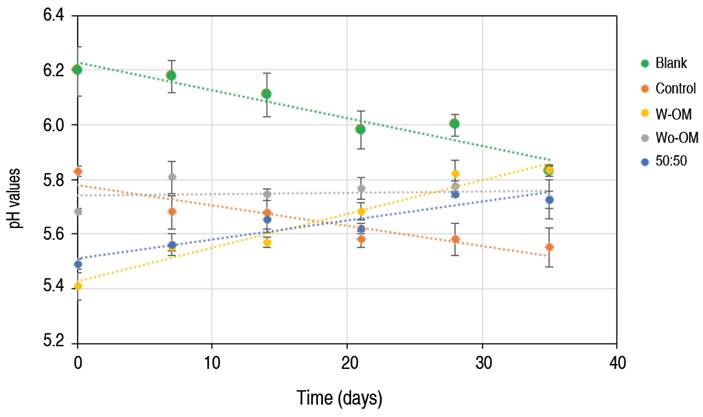
Figure 1 Soil pH. Blank: lettuce plant in leaf soil; Control: lettuce plant in alluvial soil; W-OM: lettuce plant in alluvial soil more seashells with organic matter; Wo-OM: lettuce plant in alluvial soil more seashells without organic matter, and 50:50: lettuce plant in alluvial soil more a mixture of equal masses of W-OM and Wo-OM.
Nitrogen trends in alluvial soil
Soil nitrogen is a nutrient with great impact on natural ecosystems and its decrease can cause acidification, nutrient imbalance, and loss of biodiversity, affecting the quality and yield of cultivated vegetables (Blanco and Martínez 2019).
Figure 2 shows the effect of W-OM, Wo-OM and 50:50 treatments on soil N level, which was approximately 9 mg kg-1, during the 35 days analyzed. Considering that during fertilizer preparation, the N level incorporated into soil was adjusted to 19 mg kg-1 and, given that the coffee bean (CB) waste had a severe heat treatment applied during its house preparation, therefore, it could be suggested that not all the nitrogen was available for the plant, probably, due to a protein denaturation in CB (Mazzafera et al. 2019). Additionally, given the low absorption of N, root differentiation and expression of nitrate transporters could have been affected, altering plant quality (Singh et al. 2022). Visually, this was verified because a lower number of shortened plants was found (n=3), that is, a greater leaf opening was observed in the plants (n=9), which promoted leaf dehydration (Blanco and Martínez 2019). For its part, the control treatment showed a low N level (5.8±0.1 mg kg-1), which allowed the improvement of N in the soil with the W-OM, Wo-OM, and 50:50 treatments. The blank treatment showed the highest N level, 102.6±9.2 mg kg-1, which can be explained because the leaf soil was formulated by plant and forestry waste, which represent the largest nitrogen reserve in the soil and most of this nitrogen can be available to the plant.
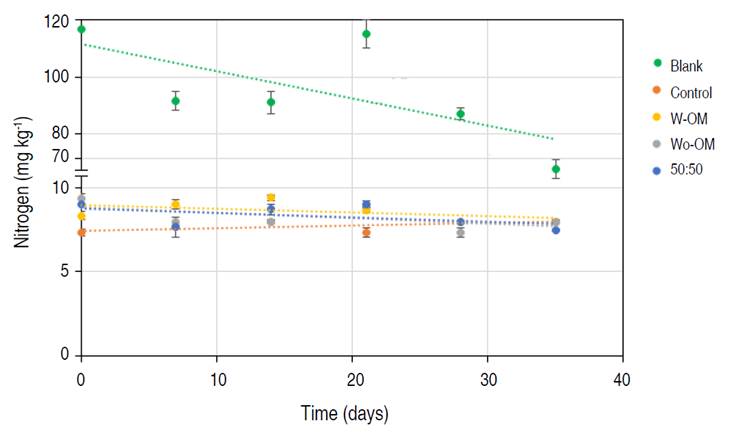
Figure 2 Nitrogen level in soil. Blank: lettuce plant in leaf soil; Control: lettuce plant in alluvial soil; W-OM: lettuce plant in alluvial soil more seashells with organic matter; Wo-OM: lettuce plant in alluvial soil more seashells without organic matter, and 50:50: lettuce plant in alluvial soil more a mixture of equal masses of W-OM and Wo-OM.
Nitrogen trends in lettuce leaves
Nitrogen is the nutrient responsible for the green pigmentation of vegetables and plays a key role in the leaf´s growth, size, and quality (Ncama and Sithole 2022; Albadwawi et al. 2022).
Figure 3 shows the effect of W-OM, Wo-OM, and 50:50 treatments on leaves N level, which exhibited an increase with time for all treatments, although the highest N level was observed in the leaves of blank treatment. Karam et al. (2002) suggest that the N level in the leaf for an ideal chlorophyll content, is the one that avoids toxicity or lack of nutrients to the plants. Therefore, the lettuce leaf plants could have exhibited a lower sensitivity to the nitrogen source incorporated into the soil because a weak appearance was observed in their leaves.
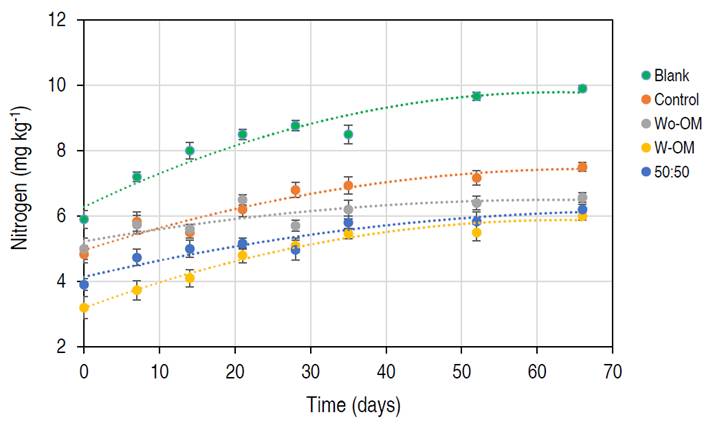
Figure 3 Nitrogen level in lettuce leaves. Blank: lettuce plant in leaf soil; Control: lettuce plant in alluvial soil; W-OM: lettuce plant in alluvial soil more seashells with organic matter; Wo-OM: lettuce plant in alluvial soil more seashells without organic matter, and 50:50: lettuce plant in alluvial soil more a mixture of equal masses of W-OM and Wo-OM.
Chlorophyll index trends in lettuce leaves
Chlorophyll is a natural and active pigment responsible for transforming light energy into chemical energy, used in plant growth (Chowdhury et al. 2021).
Figure 4 shows the effect of W-OM, Wo-OM, and 50:50 treatments on leaves chlorophyll content. An increase in chlorophyll was observed in the lettuce leaves for all treatments during the study period. These findings were consistent with a study carried out by Santos et al. (2016), which reported similar trends of chlorophyll production in lettuce leaves cultivated with a compost of natural origin. Bassi et al. (2018) reported that total chlorophyll content increases under high nitrogen supply. However, except for the blank treatment, the low nitrogen levels reported in Figure 4, could be related to the degree of nitrogen availability in the soil from coffee bean waste sources.
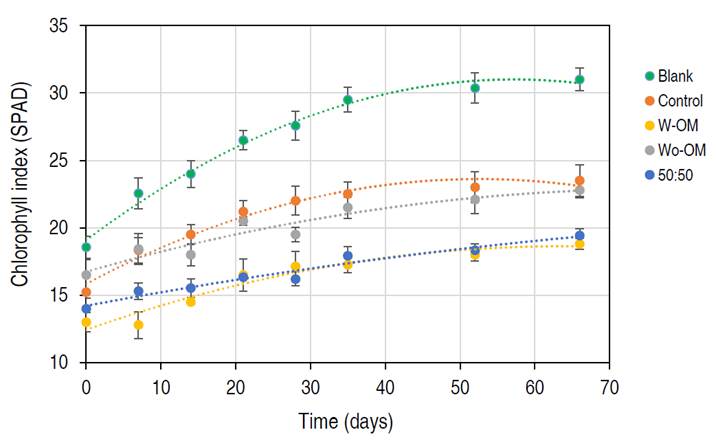
Figure 4 Chlorophyll index in lettuce leaves. Blank: lettuce plant in leaf soil; Control: lettuce plant in alluvial soil; W-OM: lettuce plant in alluvial soil more seashells with organic matter; Wo-OM: lettuce plant in alluvial soil more seashells without organic matter, and 50:50: lettuce plant in alluvial soil more a mixture of equal masses of W-OM and Wo-OM.
Vitamin C content in lettuce leaves
The vitamin C is an indicator of the nutritional value of vegetables (Medina-Lozano et al. 2021). Figure 5 shows the effect of W-OM, Wo-OM, and 50:50 treatments on the vitamin C content of lettuce leaves. It was observed that the addition of seashells improved the vitamin C content when compared to the blank treatment based on leaf soil. Specifically, the plants grown in the soil without organic matter (Wo-OM) showed a high vitamin C content (51.0±3.6 mg 100 g-1). It was observed that the organic matter content of seashells (W-OM) contributed significantly to reducing the vitamin C content in the lettuce leaves. Although, the vitamin C content in the plants from the W-OM (25.8±1.0 mg 100 g-1) and 50:50 (37.0±3.0 mg 100 g-1) soils were that of the plants from leaf soil (24.6±1.7 mg 100 g-1).
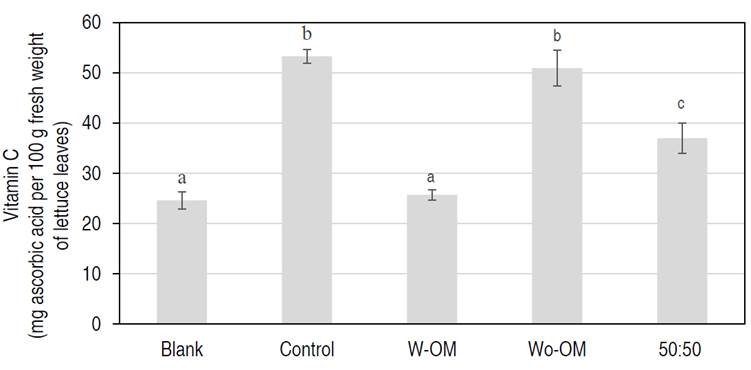
Figure 5 The vitamin C content in lettuce leaves. Blank: lettuce plant in leaf soil; Control: lettuce plant in alluvial soil; W-OM: lettuce plant in alluvial soil more seashells with organic matter; Wo-OM: lettuce plant in alluvial soil more seashells without organic matter, and 50:50: lettuce plant in alluvial soil more a mixture of equal masses of W-OM and Wo-OM.
These findings suggest that the addition of seashells without organic matter (Wo-OM) to the lettuce plants has a positive effect on the vitamin C content (51.0±3.6 mg 100 g-1), but the presence of organic matter in the seashells could reduce the vitamin C content. Lee and Kader (2000) confirm these findings and indicate that the organic waste derived from meat (as the organic matter of seashells) represents an additional nitrogen source, whose excess could partially inhibit vitamin C production in plants because the excess nitrogen increases the concentration of NO3, a known inhibitor of vitamin C production in vegetables.
CONCLUSION
The utilization of Mytilus chilensis seashells, combined with coffee beans waste, banana peels, and wood ashes, in the formulation of natural waste-based fertilizer, proved beneficial for lettuce cultivation and improving its physiological quality: i) the alluvial soil from Ñuble Coast (Ñuble Region, Chile) increased its pH value with the incorporation of seashells, ii) the coffee bean waste, as nitrogen source incorporated into the soil, were partially available for the lettuce plant, iii) the low nitrogen levels measured in the lettuce leaves could have been the cause of a low chlorophyll index on the lettuce leaves, and (iv) the seashells contributed to improving the physiological quality in the lettuce leaves expressed as vitamin C. Additionally, it is established that some improvements in fertilizer composition are required to act as an effective pH control and nitrogen supply agent. Therefore, it is recommended to identify other sources of natural wastes that provide available nitrogen for the plant´s needs.















